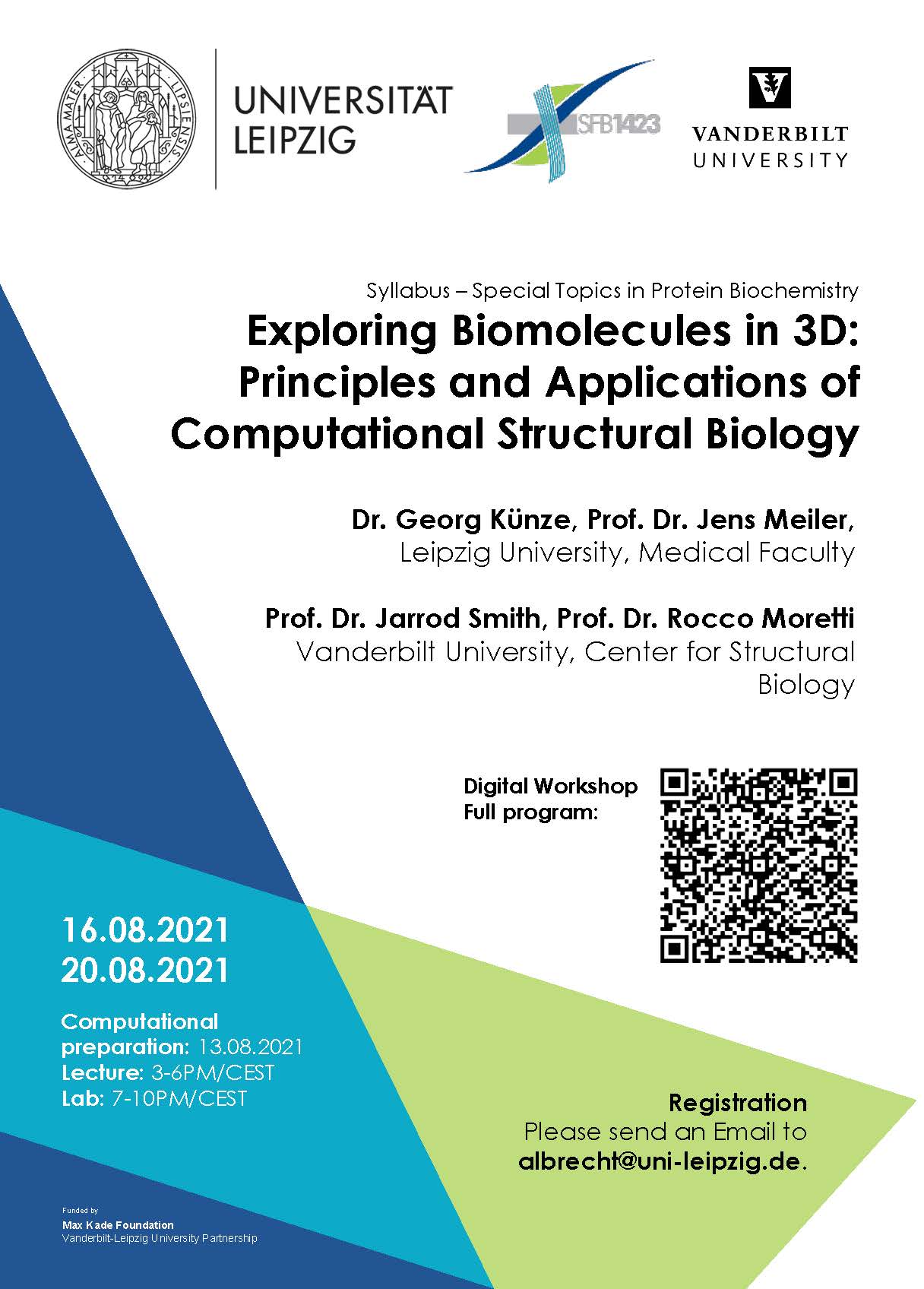16-20.08.2021: Module “Exploring Biomolecules in 3D: Principles and Applications of Computational Structural Biology”
We cordially invite you to a one week block online seminar “Exploring Biomolecules in 3D: Principles and Applications of Computational Structural Biology” by:
Prof. Dr. Jens Meiler
(Leipzig University, Coordinator)
Dr. Georg Kuenze
(Leipzig University)
Prof. Dr. Jarrod Smith
(Vanderbilt University / USA)
Prof. Dr. Rocco Moretti
(Vanderbilt University / USA)
DATE
16 – 20. August 2021, EST (13. August 2021 technical setup)
The class will meet virtually on 5 days in the week from August 16th to August 20th always 8:00 a.m. -11:00 a.m. CDT / 3:00 p.m. – 6:00 p.m. CEST. The laboratory portion will proceed on the same dates 12:00 p.m. – 3:00 p.m. CDT / 7:00 p.m. – 10:00 p.m. CEST. The laboratory portion on August 13th is indented to sort out computational issues prior to the start of the course. Additionally, a short introduction to the Linux command line will be offered on that day. This is a one credit course.
COURSE DESCRIPTION
Proteins and nucleic acids have characteristic three-dimensional structures which equip them to play specific roles as, e.g., receptors, enzymes, transporters, antibodies, or cellular scaffolds. The number of experimentally determined structures of biological macromolecules in the worldwide protein databank (PDB) has increased substantially over the last years, and more than 200,000 biomolecular structures are currently available. By analyzing these structures, we not only obtain detailed insight into the way how biomolecules function, but also gain understanding about the design principles of proteins and the evolution of protein structure on a large scale. To access, interpret, and manipulate structural data of biological macromolecules, computational methods have become an indispensable tool that enables researchers to solve diverse biological problems. For example, how do mutations in a gene affect a protein’s shape or the binding of a small-molecule substrate? How do membrane proteins couple chemical signals to the transport of small molecules or ions across the cell membrane? How can the affinity of an antibody recognizing a viral protein be increased to block virus entry into cells and prevent an infection? The course will cover the theory, computational algorithms, data resources, and practical tools used for the study of biomolecular structure. Students will get introduced into Rosetta – a comprehensive software package used for a wide range of applications such as the prediction of protein structures with and without the aid of experimental data, the modeling of the interaction of proteins and peptides with each other and with small-molecule ligands, and the design of proteins with improved or completely new functionalities. Computational structural biology methods like Rosetta become increasingly important for the interpretation of biological findings (e.g., from genomics data) and the engineering of therapeutics and probe molecules in biomedical research. The course will include practical lab exercises that will consolidate the theoretical concepts learned and train students how to use Rosetta to perform advanced computational experiments.
PROGRAM:
Program Overview (PDF)
WHO:
Students and doctoral researchers, postdocs, public, for interested parties
GRADING:
There will be a multiple-choice exam (50%) at the end of the course and the laboratory portion will be graded (50%).
ROOM:
Virtually via Zoom.
REGISTRATION:
Students who wish to take the class for credit should register as soon as possible! Students, postdocs, and faculty who wish to audit the class are welcome. Please send a note to Anett Albrecht ().
Additional Information:
For the Rosetta labs, there is a limited number of computer workstations available that students can log into remotely. Places will be preferentially given to undergraduate and PhD students who want to take the course to earn credit points. Participants may also choose to use their personal laptops to work on the Rosetta labs. Rosetta can be installed on Linux and MacOS (https://www.rosettacommons.org/demos/latest/tutorials/install_build/install_build). Unfortunately, there is no support for the whole Rosetta program on Windows, but a virtual machine running Linux/MacOS is an option. We will offer a Q&A session to help with computer setup on Friday, 13 August, 9am-12pm CDT / 4pm-7pm CEST.

